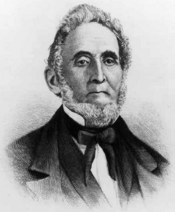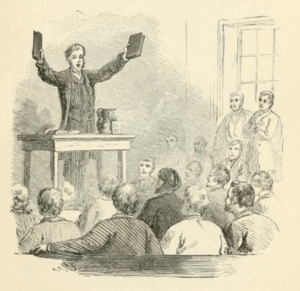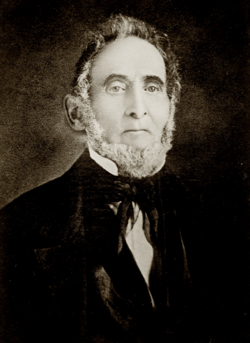Sidney Rigdon facts for kids
Quick facts for kids Sidney Rigdon |
|
|---|---|
 |
|
| President of the Church Church of Jesus Christ of the Children of Zion |
|
| April 6, 1845 – 1847 | |
| Predecessor | Joseph Smith |
| Successor | Stephen Post William Bickerton (Reorganized church in 1862) |
| Reason | Death of Joseph Smith |
| First Counselor in the First Presidency Church of Jesus Christ of Latter Day Saints |
|
| March 18, 1833 – Summer of 1844 | |
| Predecessor | Jesse Gause |
| End reason | Succession crisis after the death of Joseph Smith |
| Second Counselor in the First Presidency Church of Christ (Latter Day Saints) |
|
| March 8, 1832 – March 18, 1833 | |
| Successor | Frederick G. Williams |
| Reason | Initial organization of First Presidency |
| End reason | Called as First Counselor in First Presidency |
| Personal details | |
| Born | February 19, 1793 St. Clair Township, Pennsylvania, United States |
| Died | July 14, 1876 (aged 83) Friendship, New York, United States |
| Resting place | Maple Grove Cemetery 42°13′03″N 78°07′07″W / 42.2175°N 78.1186°W |
| Spouse(s) | Phebe Brooks |
| Children | 11 |
Sidney Rigdon (born February 19, 1793 – died July 14, 1876) was an important leader in the early days of the Latter Day Saint movement. He worked closely with Joseph Smith, the founder of the movement. Rigdon played a big role in shaping the church's early ideas and growth.
Biography
Sidney's Early Life and Learning
Sidney Rigdon was born in St. Clair Township, Pennsylvania, on February 19, 1793. He was the youngest of four children. His father was a farmer who passed away in 1810.
Young Sidney loved to read. He borrowed many history books and became very knowledgeable about the world. He also studied the Bible a lot. People said he knew the Bible as well as a child knew their spelling book. He preferred reading over playing with other boys. He even taught himself English grammar and became very good at speaking precisely.
Sidney stayed on the family farm until his mother sold it in 1818.
Becoming a Baptist Preacher
On May 31, 1817, Sidney Rigdon was baptized and joined the Peter's Creek Baptist Church. In 1818, he moved to North Sewickley to learn from a Baptist minister. He received his license to preach in March 1819.
In May 1819, Rigdon moved to Trumbull County, Ohio, where he preached with Adamson Bentley. He married Phoebe Brooks in June 1820. In 1821, Rigdon and Bentley met Alexander Campbell. Campbell believed the New Testament should be more important than the Old Testament. Rigdon and Bentley joined Campbell's movement, called the Disciples of Christ.
In 1822, Rigdon became a minister at the First Baptist Church in Pittsburgh. However, his new ideas caused disagreements. In 1823, he was removed from the Baptist group. From 1824 to 1826, Rigdon worked as a tanner and a printer. He continued to preach Campbell's ideas on Sundays. In 1826, he became the pastor of a more open-minded Baptist church in Mentor, Ohio.
Joining the Latter Day Saints
Many people who later became important Latter Day Saint leaders were part of Rigdon's church. These included Parley P. Pratt and Edward Partridge.
How Sidney Rigdon Joined the Church
In September 1830, Parley P. Pratt joined the Church of Christ, founded by Joseph Smith. In October, Pratt visited Rigdon in Ohio. Rigdon read the Book of Mormon in just two weeks. He believed it was true and was baptized into the church on November 14, 1830. He then helped many people from his own church congregations in Ohio to join the new faith.
In December 1830, Rigdon traveled to New York and met Joseph Smith. He was then ordained as a high priest. Rigdon was a powerful speaker. Smith quickly asked him to be the church's spokesman. He also worked as a scribe, helping Smith with his re-translation of the Bible.
Rigdon and Smith sometimes shared visions. One person described how they would take turns saying what they saw, and the other would confirm seeing the same thing.
Life in Kirtland, Ohio
In December 1830, Joseph Smith told church members in New York to move to Kirtland, Ohio. Many of the ideas Rigdon's group had tried, like sharing everything, became part of the combined movement.
In August 1831, Smith said he received a message from God. It warned Rigdon not to be too proud. It also said his writings were not pleasing to God. Smith moved to Hiram, Ohio, in September 1831.
On March 24, 1832, Smith and Rigdon were attacked by a mob. Smith later said Rigdon was very unwell after this event. On July 5, 1832, Rigdon taught that the church had lost its spiritual power. Many people cried, and the meeting ended in confusion. Joseph Smith returned to Kirtland and corrected Rigdon. Smith said that no one could take away his spiritual authority.
On July 28, Smith re-ordained Rigdon. On March 18, 1833, Smith formed the church's First Presidency. He chose Jesse Gause and Rigdon as his first two counselors. Rigdon became a close partner to Smith.
Rigdon strongly supported building the Kirtland Temple. He gave a powerful speech when the temple was dedicated in March 1836. When the church started the Kirtland Safety Society bank, Rigdon became its president. When the bank failed in 1837, some people blamed Rigdon and Smith.
Moving to Missouri and Illinois
Rigdon and Smith moved to Far West, Missouri, to set up a new church center. Rigdon, as the church's spokesman, gave some speeches that caused controversy. These speeches are sometimes seen as contributing to the conflict known as the 1838 Mormon War in Missouri.
Because of the conflict, the Latter Day Saints were forced to leave Missouri. Rigdon and Smith were arrested and put in Liberty Jail. Rigdon was later released and went to Illinois. He joined the main group of Latter Day Saint refugees there in 1839.
Smith then founded the city of Nauvoo, Illinois. Rigdon continued to be a church spokesman. He gave a speech at the start of building the Nauvoo Temple. In June 1841, Sidney Rigdon was ordained as a "Prophet, Seer and Revelator".
However, Rigdon and Smith's relationship became difficult in Nauvoo. Rigdon's involvement in church matters became less. He was also in poor health. In October 1843, Joseph Smith expressed his unhappiness with Rigdon. Smith wanted Rigdon to be replaced as his First Counselor. Rigdon spoke to the church members, denying the accusations. The members voted to let Rigdon keep his position. Smith reportedly said, "I have thrown him off my shoulders, and you have again put him on me. You may carry him, but I will not."
In 1844, when Smith ran for president of the United States, Rigdon was chosen as his vice-presidential running mate.
After Joseph Smith's Death
Joseph Smith was killed in 1844. Before his death, the First Presidency made most of the church's big decisions. Rigdon was the most senior surviving member of the First Presidency.
Rigdon returned to Nauvoo on August 3. The next day, he announced he had received a message from God. This message appointed him "Guardian of the Church." At a meeting on August 8, Rigdon argued that he should lead the church. Brigham Young, who was the leader of the Quorum of the Twelve Apostles, disagreed. Young said the Quorum of the Twelve Apostles should lead. The church members present voted against Rigdon's claim.
One month later, on September 8, Rigdon was removed from the church. Rigdon refused to attend this meeting. He then said that the members of the Twelve were also removed from the church. Rigdon left Nauvoo, saying he felt unsafe from Young's supporters.
Later Life and New Church
After the church split, Rigdon led his own group of Latter Day Saints. This group was first called the "Church of Christ." It was also known as the Church of Jesus Christ of the Children of Zion. These followers of Rigdon settled in Pittsburgh, Pennsylvania. On April 6, 1845, Rigdon led a meeting of his church. He said it was the true continuation of the church Joseph Smith founded. He then formed his own First Presidency and Quorum of Twelve Apostles.
Rigdon's church grew for a short time. He published a newspaper called The Messenger and Advocate. However, disagreements among his followers caused most members to leave by 1847. A few loyal people, like William Bickerton, later reorganized the church in 1862. They called it The Church of Jesus Christ.
Sidney Rigdon lived for many more years in Pennsylvania and New York. He always believed in the Book of Mormon. He also continued to say he was the rightful leader after Joseph Smith. He passed away in Friendship, New York on July 14, 1876.
Sidney Rigdon's Importance
After Joseph Smith died in 1844, the Latter Day Saint movement split into different groups. Brigham Young's group traveled west to Utah. Rigdon's group went east to Pittsburgh.
Rigdon's group did not become as large. Today, it makes up only a small part of Latter Day Saints.
Churches Connected to Rigdon's Leadership
| Name | Organized by | Date | Split off / Continuation of | Current status | Notes |
|---|---|---|---|---|---|
| Church of Jesus Christ of the Children of Zion | Sidney Rigdon | 1844 | Church of Jesus Christ of Latter Day Saints | Dissolved by 1847 | Also known as Rigdonites. |
| The Church of Jesus Christ (Bickertonite) | William Bickerton | 1862 | Organized by former members of the Church of Jesus Christ of the Children of Zion (Rigdonites), by then defunct | 12,136 as of 2007; headquartered in Monongahela, Pennsylvania | Followers are often called Bickertonites. |
| Reorganized Church of Jesus Christ (Bickertonite) | Half of the Bickertonite Quorum of Twelve Apostles | 1907 | Church of Jesus Christ (Bickertonite) | Defunct | Split over beliefs; later merged with the Primitive Church of Jesus Christ (Bickertonite). |
| Primitive Church of Jesus Christ (Bickertonite) | James Caldwell | 1914 | Church of Jesus Christ (Bickertonite) | Defunct | Did not believe in the First Presidency; later merged with the Reorganized Church of Jesus Christ (Bickertonite). |
Theories About the Book of Mormon
Some people have suggested that Sidney Rigdon might have helped write the Book of Mormon. This idea is called the Spalding-Rigdon theory of Book of Mormon authorship. This theory suggests that Rigdon found a story written by Solomon Spalding. He then supposedly changed it and added religious parts to create the Book of Mormon.
This theory first appeared in a newspaper article in 1831. It also appeared in a book in 1834. Another book in 1867 said that a "mysterious stranger," later identified as Rigdon, visited Joseph Smith early on. This stranger supposedly helped create the Book of Mormon.
However, Rigdon himself denied this theory. Before he died, he told his son, John, that he swore he only knew about the Book of Mormon's origin from what Joseph Smith and others told him. He said Smith always told him the same story. But, Rigdon's grandson, Walter Sidney Rigdon, later said that the family knew the "Golden Bible" was a trick. He claimed it was made up by Rigdon and Joseph Smith to make money, based on Spalding's story.
A computer study in 2008 looked at the text of the Book of Mormon. It suggested Rigdon might be an author. However, this study did not include Joseph Smith's writings. Also, the study's method had some problems. For example, it also suggested Rigdon wrote The Federalist Papers, which were written before he was born.
See also
 In Spanish: Sidney Rigdon para niños
In Spanish: Sidney Rigdon para niños



